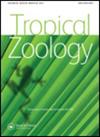Differences between anophthalmic and aphenopsian beetles: evidences from larvae of Chinese species
IF 0.7
4区 生物学
Q4 ZOOLOGY
引用次数: 0
Abstract
Larval morphology plays an important role in taxonomy and phylogeny construction. Larvae of three hypogean Trechini species, representing aphenopsian, semi-aphenopsian and anophthalmic, respectively, are described and illustrated from China. In general, primary setae were identified according to classical theory established by Bousquet and Goulet. Main larval morphological characteristics of them provide evidences between aphenopsian and anophthalmic species. The Dongodytes troglodytes Tian, Yin & Huang, 2014 (a typical aphenopsian) larva is distinct from Guizhaphaenops lipsorum Deuve, 1999 and Libotrechus nishikawai Uéno, 1998 by following characteristics: (1) anterior margin of nasale is less protruding, relatively smooth and teeth-lacking (versus distinctly toothed in G. lipsorum and L. nishikawai); (2) hypertrophied abdomen (versus slender in G. lipsorum and L. nishikawai); (3) short and stout pygidium (versus relatively slender in G. lipsorum and L. nishikawai). These major differences above may suggest various larval adaptation degrees of the cave-strictly trechine beetles to the subterranean habitats.无眼球甲虫和无眼球甲虫的差异:来自中国物种幼虫的证据
幼虫形态在分类学和系统发育构建中起着重要作用。描述和说明了中国三种低等Trechini的幼虫,分别代表无眼球、半无眼球和无眼球。一般来说,初级刚毛是根据Bousquet和Goulet建立的经典理论鉴定的。它们的主要幼虫形态特征为无眼球种和无眼球种之间的关系提供了证据。Dongodytes troglodytes Tian,Yin&Huang,2014(一种典型的无翅目)幼虫与Guizhaphaenops lipsorum Deuve,1999和Libotrechus nishikawai Uéno,1998有以下特征:(1)鼻翼前缘突起较少,相对光滑,缺齿(而G.lipsorum和L.nishikawa有明显的齿);(2) 腹部肥大(与唇柄藻和西关外藻的细长相比);(3) 矮而粗壮的扁盖藻(与G.lipsorum和L.nishikawai相对纤细)。上述主要差异可能表明洞穴甲虫幼虫对地下栖息地的适应程度不同。
本文章由计算机程序翻译,如有差异,请以英文原文为准。
求助全文
约1分钟内获得全文
求助全文
来源期刊

Tropical Zoology
生物-动物学
CiteScore
2.50
自引率
0.00%
发文量
1
审稿时长
>12 weeks
期刊介绍:
Tropical Zoology is an international zoological journal publishing original papers in the field of systematics, biogeography, phylogeny, ecology and conservation of all terrestrial and aquatic animal Phyla from tropical and subtropical areas.
Only papers with new information, high quality and broad interest are considered. Single species description and checklists are not normally accepted. Review papers are welcome. The journal is owned by the Istituto di Ricerca sugli Ecosistemi Terrestri of the Consiglio Nazionale delle Ricerche, Florence, Italy (CNR-IRET) who performs research into the structure and functioning of aquatic and terrestrial ecosystems, focusing in particular on anthropogenic pressure and global change. The knowledge amassed forms the scientific basis for identifying the most appropriate protective and corrective interventions, and provides support for the bodies entrusted with formulating policies for environmental protection and recovery.
 求助内容:
求助内容: 应助结果提醒方式:
应助结果提醒方式:


